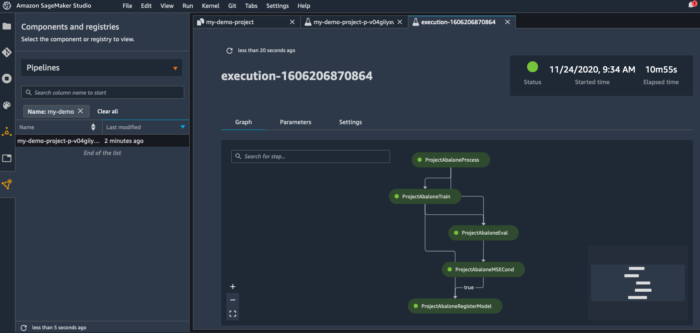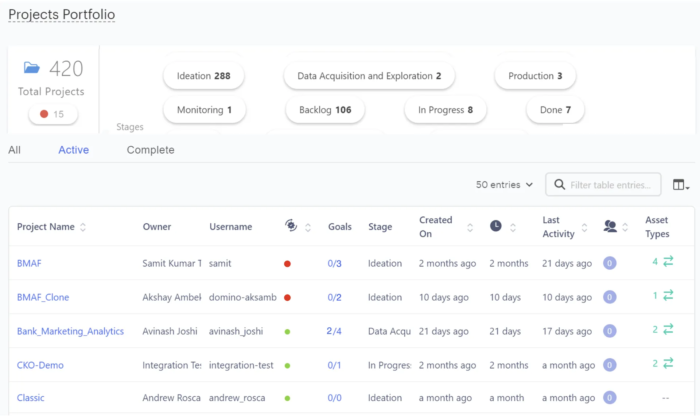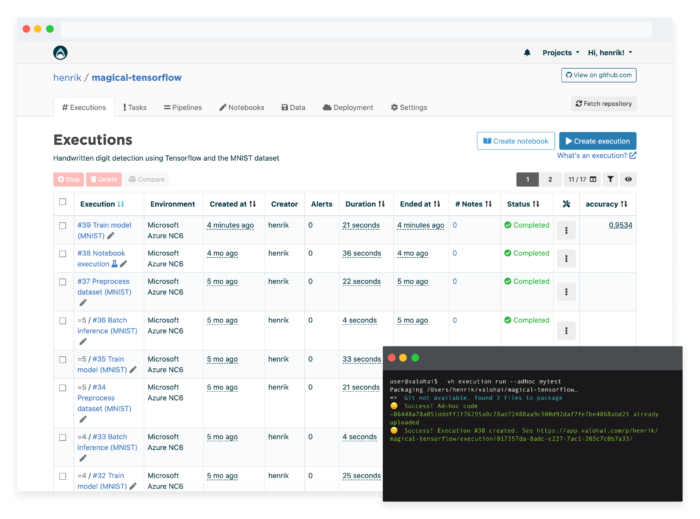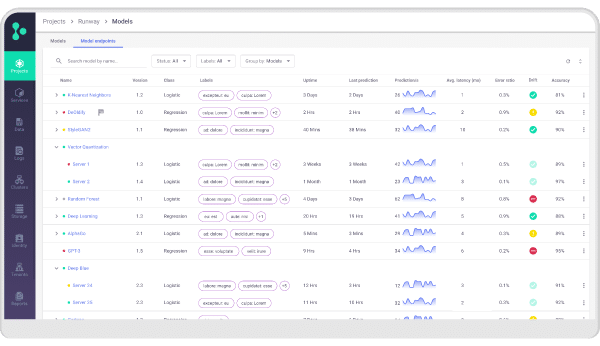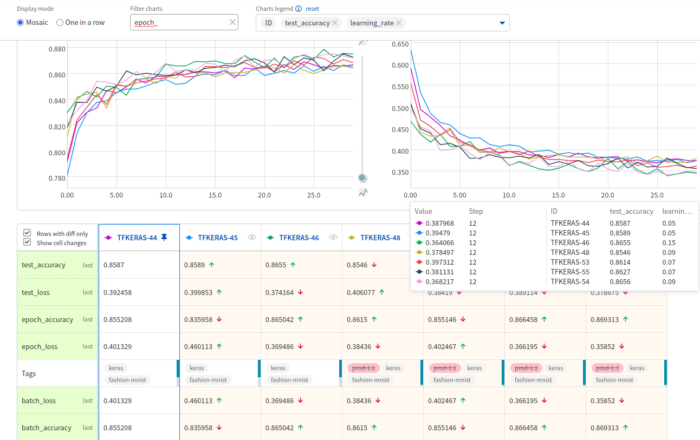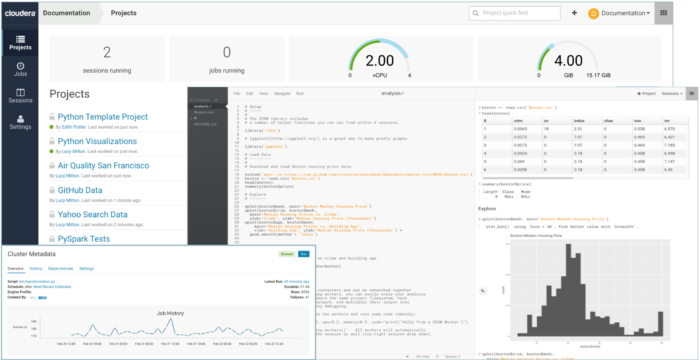
A variety of industries around the globe are beginning to invest more heavily in machine learning (ML). Teams of experts can get ML models off the ground and running initially, but one of the greatest challenges is applying those lessons learned to the next model so processes can be scaled.
MLOps strategies are increasingly being applied to machine learning models and the teams that build them to optimize and standardize the procedures that go into model lifecycle management.
Read on to learn about some of the top MLOps tools and platforms on the market, and what they can do to simplify machine learning from a tool, developer, and procedural perspective.
Also read: AI Software Trends
What Is MLOps?
Machine learning operations, typically called MLOps, is a strategy for establishing procedures, standards, and best practices for machine learning models. Instead of pouring extensive time and resources into machine learning development without a plan, MLOps works to ensure the full lifecycle of ML development — from ideation to deployment — is carefully documented and managed for optimized outcomes.
MLOps exists not only to improve the quality and security of ML models, but also to document best practices in a way that makes machine learning development more scalable for ML operators and developers.
Because MLOps effectively applies DevOps strategies to a more niche area of technical development, some call it DevOps for machine learning. This is a helpful way to view MLOps, because much like DevOps, it’s all about knowledge sharing, collaboration, and best practices across teams and tools; MLOps gives developers, data scientists, and operations teams a guide for working together and creating the most effective ML models as a result.
More on DevOps: Best DevOps Tools
What Do MLOps Tools Do?
MLOps tools can do a variety of tasks for an ML team, but typically, these tools can be divided into two categories: individual component management and platform management. While some MLOps tools specialize in one core area, like data or metadata management, other tools take a more holistic approach and offer an MLOps platform to manage several pieces of the ML lifecycle.
Whether you’re looking at a specialized or more general tool for MLOps, look for tools that help your team to manage these areas of ML development:
- Data management
- Modeling and design
- Deployment and ongoing maintenance of ML models
- End-to-end lifecycle management, which is usually available in full-service MLOps platforms
- Project and workspace management
Learn more about AI, ML, tools, and use cases: AI vs Machine Learning: What Are Their Differences & Impacts?
Best MLOps Tools & Platforms
Amazon SageMaker
Best for Model Monitoring and Drift Management
Amazon SageMaker is a leading MLOps platform for many reasons, but its focus on monitoring and drift management helps teams most. The platform gives teams alerts to models, algorithms, and data sets that need to be adjusted over time. Some core areas of focus for Amazon SageMaker include real-time model and concept drift tracking, as well as prediction accuracy monitoring and bias alerting.
Features:
- Automated bias, model drift, and concept drift detection
- Automated data loading, data transformation, model building, training, and tuning via Amazon SageMaker Pipelines
- CI/CD through source and version control, automated testing, and end-to-end automation
- Workflow logging for training data, platform configurations, model parameters, and learning gradients
- Security features for policy management and enforcement, infrastructure security, data protection, authorization, authentication, and monitoring
Pricing: Find different pricing scenarios and examples from Amazon here.
Domino Data Lab
Best for Collaboration and Research
Domino Data Lab‘s Domino Data Science Platform is a popular platform for teams that focus on data management, especially because it focuses on creating centralized storage and visualization spaces for MLOps data. Domino’s platform is a strong solution for teams that want to lean into data democratization because they offer so many learning and templating resources — such as their Knowledge Center and their Workbench.
Features:
- Knowledge Center for project management and templated best practices repository
- Workbench for collaborative research, progress tracking, and self-serve tools
- Launchpad tool for efficient model and application deployment
- Enterprise Infrastructure Foundation for security, compliance, and self-service management
- On-demand data access with scalable storage, compute, and tooling
Pricing: Pricing offered directly by Domino sales team. A 14-day free trial is available.
Valohai
Best for Full-Cycle Automation
Valohai offers its customers a variety of pipelines, workflows, and other automated deployment solutions that simplify lifecycle management for multiple ML models at once. Many customers also select Valohai because of how its open API allows the tool to flexibly integrate with outside hardware and tools, such as preexisting CI/CD pipelines.
Features:
- API-friendly ML pipelines that can automate model retraining
- Multiversion deployment with A/B testing
- Workflow automation with data fetching, preprocessing, synthetic data generation, and hyperparameter sweeps
- Security features such as Single Sign-On (SSO), Two Factor Authentication (2FA), and Active Directory (AD)
- Visualization for parallel hyperparameter tuning runs
Pricing: Pro and Enterprise pricing packages are available. Pricing information is offered directly by the Valohai sales team.
Iguazio
Best for Feature Engineering
Iguazio includes many of the same features that other full-service MLOps platforms advertise, but it particularly shines with its feature engineering solutions. It simplifies collaborative feature engineering with real-time aggregation and streaming data. The tool also offers native feature store integration, low-code/no-code conversions, and graphing and data visualizations to help engineers continually manage the features they’ve created.
Features:
- Model monitoring with drift detection and automated retraining
- Real-time serverless technology for pipeline development
- CI/CD through ML, Git, and CI/CD frameworks
- Feature engineering with nature feature store integration
- GPU as a service solution included
Pricing: A 14-day free trial is available. Pricing is offered directly by the Iguazio sales team.
H2O MLOps
Best for Container and Testing Environment Flexibility
H2O MLOps is one of many top-tier solutions provided by H2O for machine learning and artificial intelligence tooling. Many MLOps teams select this tool because of the flexibility of testing and deployment environments that work with the platform. Teams can construct several different environments for development, testing, and production. Further, the platform has the flexibility to work with cloud, on-premises, and container infrastructures.
Features:
- Integration with H2O Driverless AI and H2O open source
- Support for major cloud providers and on-premise Kubernetes distributions (e.g. RedHat OpenShift)
- Real-time dashboarding and alerting for service levels and data drift
- Update, troubleshoot, and A/B test models in different environments
- Model repository that includes version control, access control, and data logging
Pricing: 14 days of free access to the H2O AI Cloud. Pricing is available by request from the H2O sales team.
MLflow
Best for Open-Source Integration Opportunities
MLflow is an open-source lifecycle management platform that allows for more customizations than many of its closed-source competitors. This tool also integrates with several other popular MLOps solutions, such as H2O.ai, Amazon SageMaker, Databricks, Google Cloud, Azure Machine Learning, Docker, and Kubernetes.
Features:
- Compatible with a wide range of ML libraries, codes, and languages
- MLflow tracking to record and query experiments
- MLflow projects to package data science code in a reproducible format
- Model registry to store, annotate, discover, and manage models in a single location
- MLflow models to deploy models in varied serving environments
Pricing: Free and open-source version available. MLflow is also available as an add-on for select other MLOps tools.
Neptune.ai
Best for Metadata Storage and Management
Neptune.ai focuses on one key area of the MLOps lifecycle: metadata storage and management. Users can easily log, organize, search, catalog, and store all kinds of metadata for their ML models with this tool. Neptune’s strategic focus on in-depth metadata knowledge makes it a strong solution for teams that want to focus on research, experimentation, and more complicated builds requiring deeper data insights.
Features:
- ML data store for model building metadata management
- Artifact and model metadata logging
- Model registry for version history and easy search
- Database dashboard with data visualizations
- Version history and data comparisons through table visualizations
Pricing: Find SaaS and private infrastructure pricing options here.
Cloudera Data Platform
Best for Shared Data Experience (SDX) Features
Cloudera Data Platform is a platform with several subcategories, such as Machine Learning and Shared Data Experience (SDX). The Machine Learning module offers several fundamental MLOps features, but it’s the SDX solution that sets Cloudera apart. SDX provides users with increased visibility and guided management for data security, compliance, and other data governance needs. Especially as several team members work with new and sensitive data, SDX helps companies to stay compliant and secure while building ML models.
Features:
- Applied ML prototypes available for templated use cases
- Model tuning with hyperparameter tuning
- Self-service, drag-and-drop data visualizations
- SDX for integrated security and governance solutions
- Multi-tenant data policy configuration
Pricing: Pricing differs based on the selected hosting platform and modular features. Find full pricing information here.
Key Features of MLOps Tools
When selecting an MLOps tool for your organization, it’s important to see what features the tool offers in these key categories:
- Open- vs closed-source: There’s no right or wrong format for an MLOps tool, but open-source and closed-source tools offer different benefits. Open-source solutions often offer free versions that can easily integrate with other MLOps tools. However, they can be more difficult to configure if your team has fewer developers.
- Platform vs specific tools: Some MLOps solutions come in a platform format that addresses several components of ML model lifecycle management. Other tools provide more focused support for a specific step in the ML development process.
- Model and production environment monitoring: Model and environment monitoring ensure that production bugs are documented and addressed, but can also help MLOps teams to catch things like security and compliance concerns.
- Model templating and cataloging: Once a strong model has been created, many teams want to duplicate and scale that model several times over. Tools that offer templating for these models, as well as those that make it easy to find templates through catalogs, are favorites among MLOps teams.
- Model training, tuning, and drift management: Models need to be trained, not only during the initial build and deployment, but also as data and algorithm needs change over time. Many MLOps solutions offer automated training and model tweaks.
- Pipeline management: Pipelines can automate different MLOps steps in coding, data management, and model building. Look for tools that help teams to manage that pipeline. Some even automatically trigger updated builds in these core areas when a change occurs.
- Collaboration and communication capabilities: Does this tool offer an embedded communication tool or ways to document comments, questions, and other notes on models? If not, look for a tool that can integrate well with existing team communication and collaboration tools, like Slack.
More on security and compliance: What Is Governance, Risk and Compliance (GRC)?
Who Needs MLOps?
Because of the various resources they provide, MLOps tools are useful for a variety of corporate teams and machine learning use cases. Company teams in these scenarios should consider investing in an MLOps tool:
- Looking to build complicated machine learning models: MLOps tools help with templating, logging, searching, and other steps that are necessary for learning how to build and rebuild machine learning models.
- Scaling existing machine learning models: Again, standardization is key for streamlining and speeding up ML development workflows.
- Attempting to democratize ML development for the team: MLOps tools rely on visualizations and several self-service tools to make ML more accessible.
- Creating greater visibility for company tools: MLOps tools provide extensive documentation and version history, making it possible for teams to know what works, and to factor that data into business intelligence and future planning.
Getting MLOps teams organized: Guide to the 5 Types of Change Management
Benefits of Using MLOps Tools for Enterprise
MLOps tools offer a slew of benefits when the strategies and tools are implemented correctly in an organization:
- Lifecycle management: MLOps makes it easier to optimize and speed up ML model development with templates and other standardized guidelines.
- Templated workflows and models: Templates are a key feature in many MLOps tools, which makes it easier for users to save successful projects and pull from that data in the future.
- Democratization: With an emphasis on data, workflow, and model visibility, MLOps tools offer dashboards, data visualizations, and other tools to make it possible for users of different skill levels and professional backgrounds to contribute to the MLOps process.
- Improved data quality and management: Several MLOps tools offer logging, metadata stores and management, and other solutions that emphasize data quality and accessibility.
- Automation: Some ML model management steps traditionally require more tedious, hands-on work. MLOps tools can automate certain steps, like data cleansing, which reduces manual work for MLOps teammates.
The Risks of MLOps
MLOps offers exciting opportunities for advancement and standardizing best practices in machine learning development. However, like any other innovation in the tech and procedural space, there are several risks that new users should recognize and work to prevent.
Data Quality Management
Machine learning models can only work effectively if they have the right training and logging data stored in the system. Especially as data grows in quantity, data quality can become more challenging to check and improve. You also run the risk of collecting the wrong data or deleting important data for your models.
“Make sure your team has an effective data management strategy before you dive into the deep end of machine learning development.”
While many MLOps tools offer built-in data quality solutions, they don’t all offer these kinds of safety nets, and the tools themselves can never fully account for all business use cases.
Consider looking into additional data quality, preparation, and cleansing tools to optimize your model’s initial development. Even more importantly, make sure your team has an effective data management strategy before you dive into the deep end of machine learning development.
Team Collaboration and Breaking Down Silos
MLOps tools offer communication, visualization, dashboards, and other democratization tools. These resources make it easier for teams with different professional backgrounds to collaborate on ML development. But collaborative tools only effectively break down silos when all teams equally understand and commit to the collaborative expectations of an MLOps strategy.
Before investing in an MLOps tool, make sure that all important stakeholders, across development and operations teams, understand the following features:
- Why this MLOps platform or specialty tool was selected
- What collaboration tools are available on the platform and how each team member is expected to use these tools
- The types of ML projects that this team is expected to work on together
- Which parts of the lifecycle each team or team member will be held accountable for managing
Identifying Business Use Cases and Roadmaps
Machine learning is such an exciting new field for business process automation and other rising competitive advantages. However, some organizations jump directly into ML model building without a plan. This frequently results in significant time, money, and resources spent on a model that doesn’t actually create value for the business.
Businesses that are interested in creating ML models should not only focus on optimizing the models themselves through MLOps, but should also consider greater business initiatives and executive plans for the future.
It’s a good idea for your MLOps team(s) to sit down with executive leadership to create an ML roadmap. This meeting will make machine learning development and MLOps team goals better align with the resources and expectations from the executive level.
Read next: Top Cloud Computing Companies for 2022
